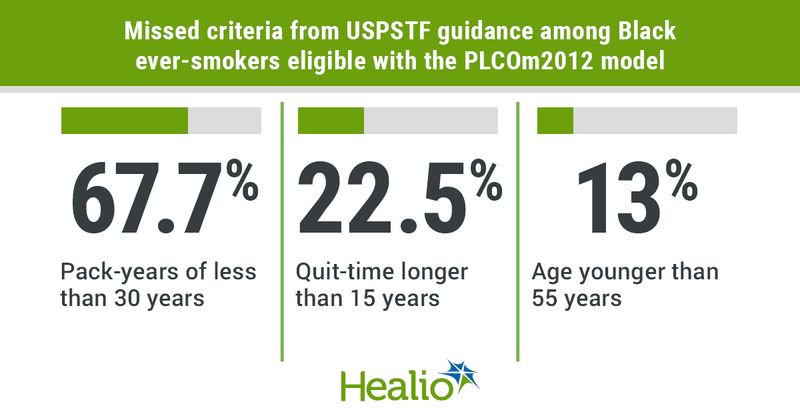Risk prediction model may reduce racial disparities in lung cancer screening, outcomes
Certain lung cancer screening guidelines appear to undercount Black people, thus contributing to disparities in screening and treatment, according to study results published in Journal of Thoracic Oncology.
“I had noticed that many of our [patients with lung cancer] would not have met eligibility criteria for lung cancer screening if they had been screened. For this reason, we reviewed our [population of patients with lung cancer] to determine the percentage of patients who would not have met the current U.S. Preventive Task Force eligibility criteria — indeed, about half of our [patients with lung cancer] would not have been eligible for screening based on smoking history and age alone,” Mary M. Pasquinelli, DNP, FNP-BC, APRN, researcher in the department of pulmonary and medical oncology and adjunct clinical instructor at University of Illinois at Chicago, told Healio. “Upon further review of our data, we found that Black patients with lung cancer were also less likely to be eligible for screening compared with their white counterparts. This study gives us a deeper understanding of the disparity in lung cancer and lung cancer screening and also identifies an effective model — the Prostate, Lung, Colorectal and Ovarian Cancer Screening Trial Model 2012 (PLCOm2012) — to overcome this race disparity.”

Current USPSTF eligibility criteria for lung cancer screening are based solely upon age and smoking history. However, it has been suggested that this criteria may exacerbate racial disparities.
Pasquinelli and colleagues evaluated whether the PLCOm2012 risk prediction model would more effectively select Black ever-smokers for lung cancer screening. This model is based on 11 predictors, including sociodemographic, medical history and four smoking exposure variables (former or current smoking status, average number of cigarettes smoked each day, smoking duration and years quit prior to diagnosis).
Researchers reviewed screening eligibility based on the USPSTF criteria compared with the PLCOm2012 model among 883 ever-smokers with lung cancer treated at an urban medical center between 2010 and 2019.
Most patients (56.3%) were Black, followed by white (29.2%), Hispanic (7.8%), other (4%) and Asian (2.7%).
Results showed the PLCOm2012 model had higher sensitivity for Black patients at 6-year lung cancer risk thresholds of 1.51%, 1.7% and 2% (P < .0001).
For instance, compared with USPSTF risk criteria, the PLCOm2012 model identified more lung cancer cases among black patients at a risk threshold of 1.7% (71.3% vs. 50.3%; P < .0001). Conversely, researchers observed no significant differences between the USPSTF eligibility criteria and the risk model at the 1.7% threshold among white patients (62.4% vs. 66%).
“Using a high-quality risk prediction model, such as the PLCOm2012, can improve sensitivity for screening and improve racial disparities,” Pasquinelli said. “What surprised us was that the magnitude of benefit for this disparity was so large. Also, even though the number of patients was small, a benefit was observed using the PLCOm2012 no-race model for Hispanic and Asian patients, as well.”
Researchers tested the no-race model — a reparameterized version of the PLCOm2012 model without the race/ethnicity predictor — in a comparative analysis.
Criteria missed from the USPSTF among Black ever-smokers eligible with the PLCOm2012 model at the 1.7% risk threshold included less than 30 smoking pack-years (67.7%), quit time longer than 15 years (22.5%) and age younger than 55 years (13%).
Nearly half (49.1%) of Black ever-smokers who did not qualify for screening according to USPSTF criteria because they had quit smoking more than 15 years ago would have qualified by the PLCOm2012 model at the 1.7% threshold. Further, 23.1% of black ever-smokers ineligible because they were aged younger than 55 years and 40.1% of those ineligible because they had fewer than 30 pack-years of smoking would have qualified for screening by the PLCOm2012 model.
“The clinical implications of this research are that eligibility for lung cancer screening should be based on multiple risk predictors that are not only based on smoking history and age alone,” Pasquinelli said. “We have already begun further research comparing the 2020 proposed USPSTF draft guidelines with the PLCOm2012 model and are finding that it will likely be better at screening patients for lung cancer. We are also looking at disparities related to gender, socioeconomic status and social determinants of health. Ultimately, we hope to improve knowledge and develop a better understanding of lung cancer disparities and how to eliminate them.”
For more information:
Mary M. Pasquinelli, DNP, FNP-BC, APRN, can be reached at University of Illinois at Chicago, 840 S. Wood St., Room 920N, CSB (MC 719), Chicago, IL 60612; email: mpasqu3@uic.edu.
